Physical Address
304 North Cardinal St.
Dorchester Center, MA 02124
The nasal septum plays a key role in the form and function of the nose, nasal cavity, and paranasal sinuses.
Septal deformities are common and occur in nearly 77% to 90% of the general population worldwide.
Even small deviations in key areas have been shown to adversely affect nasal airflow, delivery of nasal medications, mucociliary clearance, and the external appearance of the nose.
Improving nasal airflow continues to be the primary goal of nasal septal surgery. Other indications include epistaxis, sinusitis, obstructive sleep apnea, and headaches.
This chapter focuses on three commonly used septoplasty techniques: traditional septoplasty performed with a headlight; septoplasty addressing caudal deformities; and endoscopic septoplasty, both for diffuse deflections and the directed endoscopic septoplasty approach, to address focal septal deviations (spurs).
The nasal septum is a mucosa-covered bony and cartilaginous structure located in the rough midline of the nose, which separates the right nostril from the left nostril ( Fig. 1.1 ).
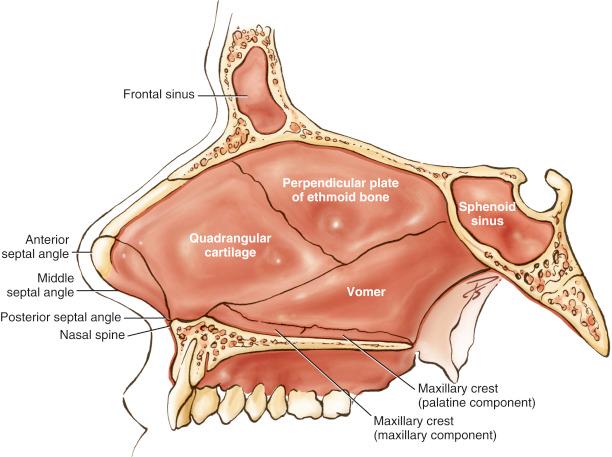
The nasal septum is situated in a sagittal plane extending from the skull base superiorly to the hard palate inferiorly and the nasal tip anteriorly to the sphenoid sinus and nasopharynx posteriorly.
The bony portion of the septum includes the perpendicular plate of the ethmoid bone, the vomer, and the maxillary crest, which has contributions from the maxillary and palatine bones. The quadrangular cartilage forms the caudal portion of the septum.
At the junction of the osseous and cartilaginous portions of the septum, the perichondrium and periosteum are not contiguous. Between the two layers are dense decussating fibers.
The nasal septum forms the medial wall of each nasal cavity and contributes to the internal and external nasal valves.
Patient history is important in establishing an operative plan. Preoperative history taking should elicit information regarding subjective nasal airway obstruction, prior trauma, epistaxis, nasal decongestant use, and drug use.
Adequate mucosal decongestion and vasoconstriction are essential in reducing intraoperative bleeding and optimizing visualization during the procedure.
Endoscopic examination prior to surgery is a valuable adjunct to anterior rhinoscopy to completely examine the nasal septum and allow accurate identification of the location and severity of a septal deviation.
Choice of septoplasty technique should be based on the nature and location of the deformity; patient history, including prior septoplasty; and surgeon skill and preference.
Radiographic evaluation is not necessary to diagnose a septal deviation prior to surgery but is often available when septoplasty is performed in conjunction with other rhinologic procedures.
When available, coronal computed tomographic (CT) scan of the sinuses is the preferred study to evaluate the course of the nasal septum ( Fig. 1.2 ).
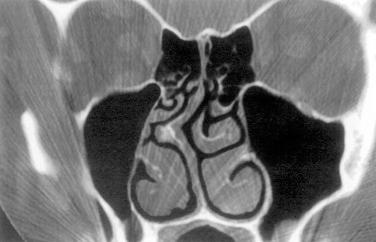
The coronal CT scan may assist in identifying posterior deflections not visualized on anterior rhinoscopy or other sources of nasal obstruction, such as a concha bullosa.
Despite its value, a CT scan may not accurately demonstrate the degree of septal deviation evident on physical examination.
Nasal specula of multiple lengths
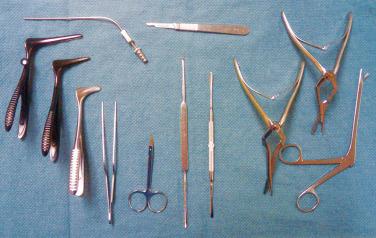
Bayonet forceps
Scalpel with a No. 15 or No. 15C blade
Small curved, sharp-pointed scissors
Cottle elevator
Freer elevator
Takahashi forceps
Open and closed double-action rongeur (Jansen-Middleton type)
0-degree endoscope with lens cleaner (endoscopic technique)
Suction Freer elevator (endoscopic technique)
Establishing the proper subperichondrial plane before elevating the mucoperichondrial flap is essential to ensure a bloodless dissection and minimize the risk of tearing the mucosa.
Bare cartilage is identified by its pearly white appearance and somewhat gritty feel.
Septal perforations are an uncommon complication following septoplasty. The risk is increased when bilateral opposing mucosal tears occur during flap elevation
It is important to maintain a generous L-strut of at least 15 mm along the dorsal and caudal margins of the quadrangular cartilage to avoid long-term nasal tip and dorsal deformities ( Fig. 1.4 ).
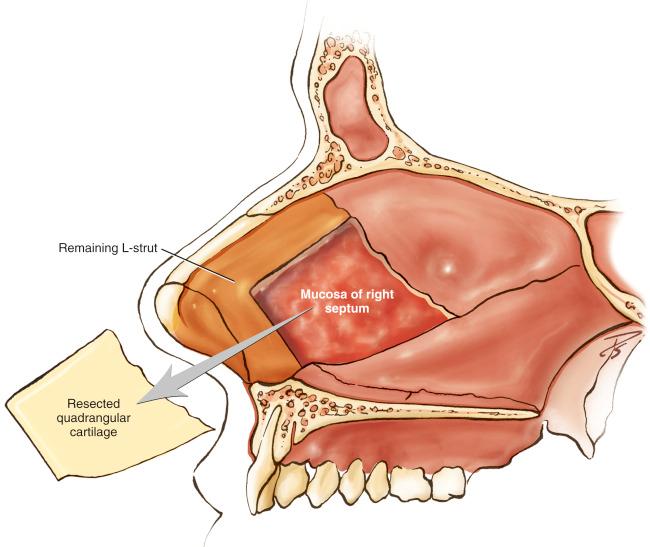
Care should be taken when addressing deviation of the ethmoid bone perpendicular plate, as aggressive manipulation can violate the anterior skull base and cause a cerebrospinal fluid leak.
After adequate nasal decongestion is achieved using a topical agent, inject local anesthetic with a vasoconstrictor (1% lidocaine with 1:100,000 epinephrine) into the septal mucosa. Allow approximately 15 minutes for the anesthetic to take full effect.
Retract the columella to the opposite side using a small nasal speculum, columellar retractor, or large two-prong hook and expose the caudal margin of the septum.
Use a No. 15 blade or No. 15C blade to make a hemitransfixion incision along the caudal margin of the septum extending from the anterior septal angle to the posterior septal angle.
A modified Killian incision may be used when more posterior deflections are being addressed or when less exposure is necessary ( Fig. 1.5 ).
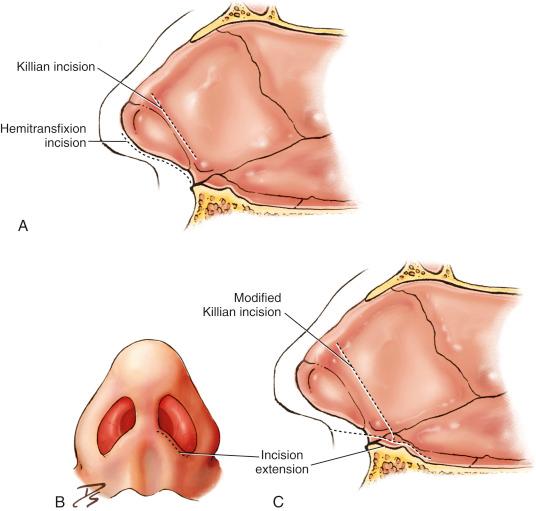
Become a Clinical Tree membership for Full access and enjoy Unlimited articles
If you are a member. Log in here